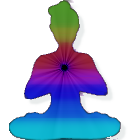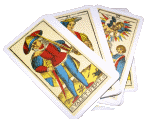
Universal Tarot
III - THE EMPRESS
If one aspect of the Priestess is her secret, unknowable nature, then what should be emphasised about the Empress is her receptivity and openness. She is the archetypal earth mother. Generally one would think that the qualities of a mother were all benevolent, nourishing, protecting, but the Earth Mother has her dark aspects too, like the Great Sea. Demeter mourned for three winter months every year; her folly was resistance to change, and nature is change. A mother can smother if she doesn't allow her offspring to grow. The lesson to be learned is one of adaptability, of being in tune with nature. Spring follows the bleakest winter, and the green leaves seen here represent dominion from Spring to Autumn. They are not brown Autumnal leaves, they are the green leaves of nature's early blossoming, they fall as spring rain. These particular leaves are from the ivy-leaved toadflax, also aptly called the 'mother of millions'.
The most profound image of motherhood is probably pregnancy or childbearing. As Spring is traditionally the time for perception and birth of new ideas, so the Empress is surrounded by the symbols of birth, proliferation and procreation. Tauret, the Egyptian goddess of childbirth, is portrayed as a pregnant hippopotamus with the hind legs of a lion. She rests her hand on a roll of papyrus. This papyrus eventually came to be the glyph which signified her protection. At the feet of the Empress is a Polynesian Tiki statue. The Maoris believe that the first Tiki was made for the goddess of childbirth by her father to ensure fertility, health of progeny and good fortune.
The crane and particularly the migration of the crane, epitomises the coming of Spring with its increasing warmth, fertility and rituals of mating. However, the pelican is a more esoteric symbol. She is a bird who nourishes her young with her own flesh - this also relates to the symbolism of Christianity and self-sacrifice - thus demonstrating the selfless giving and maternal strength of the Empress. It is interesting to note that the Virgin Mary contains both the persona of the Priestess (before the birth of Christ) and the Empress (after giving birth to him). The crown which adorns her head is a traditional sign for impregnation. It is a 'yoni-yantra' ' and also indicates the Christ child within the Virgin. The daughter of Demeter, Persephone, was abducted by Hades. As retribution Demeter allowed the earth to become barren. Eventually a compromise was arranged by Hermes whereby Persephone was permitted to stay with her mother, except for three months of the year when she would return to the underworld of Hades. So during that time the earth still lay barren and Demeter would mourn. After every winter Persephone would be returned to Demeter, ushering in the Spring, and restoring life and abundance to the world. See also the Three of Cups .
This card is governed by Venus. Female energy and love are given predominance here. In the major arcana the Empress precedes the Emperor , emphasising that she is the ruler of men; her female intuitive power is not matched by his rational power. She wears seven pearls around her neck to represent her ruling planet, and her staff bears the sign of Venus.
However, the real energy of this card should not be thought to be 'airy-fairy' or over-sensual; it is one of pragmatism and realism. Spiritually, there is an understanding in the perfection of nature. This could be the onset of a more earthly, or earthy, life. It is a time for facing up to practicalities and creating a basis for growth. The Empress denotes marriage, childbirth, a fruitful harvest. She reconciles opposites. She understands the law of growth, destruction and renewal. This is why her number is three, the number of synthesis, harmony and adaptation to the natural environment.










